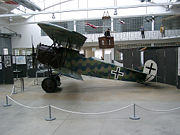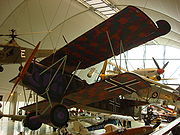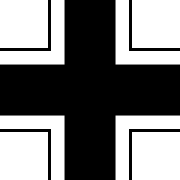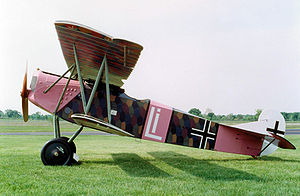
Lozenge camouflage
Encyclopedia


Military camouflage
Military camouflage is one of many means of deceiving an enemy. In practice, it is the application of colour and materials to battledress and military equipment to conceal them from visual observation. The French slang word camouflage came into common English usage during World War I when the...
scheme in the form of patterned cloth or painted designs used by some aircraft of the Central Powers
Central Powers
The Central Powers were one of the two warring factions in World War I , composed of the German Empire, the Austro-Hungarian Empire, the Ottoman Empire, and the Kingdom of Bulgaria...
in the last two years of . It takes its name from the repeated polygon
Polygon
In geometry a polygon is a flat shape consisting of straight lines that are joined to form a closed chain orcircuit.A polygon is traditionally a plane figure that is bounded by a closed path, composed of a finite sequence of straight line segments...
shapes incorporated in the designs, many of which resembled lozenge
Lozenge
A lozenge , often referred to as a diamond, is a form of rhombus. The definition of lozenge is not strictly fixed, and it is sometimes used simply as a synonym for rhombus. Most often, though, lozenge refers to a thin rhombus—a rhombus with acute angles of 45°...
s. In Germany it was called Buntfarbenaufdruck (multi-colored print) but this designation includes other camouflage designs such as Splittermuster
Splittermuster
Splittermuster was a four-colour military camouflage pattern developed by Germany in the late 1920's, and was first issued to the Reichswehr in 1931. It was first printed on the newly designed and issued triangular tent/poncho called the dreieckszeltbahn...
and Leibermuster
Leibermuster
Leibermuster was a six-color military camouflage pattern developed by the Third Reich in February 1945. Known in German as "Buntfarbenaufdruck 45" for its year of introduction, Leibermuster was issued on a very limited basis to combat units before the war ended. It was the first pattern issued...
, and does not include hand-painted camouflage. Some modern German sources refer to lozenge camouflage as Lozenge-Tarnung, as tarnung means concealment, cloaking or camouflage.
Development
During the early stages of the Great War, the GermansGermany
Germany , officially the Federal Republic of Germany , is a federal parliamentary republic in Europe. The country consists of 16 states while the capital and largest city is Berlin. Germany covers an area of 357,021 km2 and has a largely temperate seasonal climate...
were looking for a way to effectively camouflage the aircraft
Aircraft camouflage
Aircraft camouflage is the use of light and color patterns applied to military aircraft for the purpose of making an aircraft more difficult to see on the ground, in the air, or to make its speed, distance or attitude difficult to determine...
of the Luftstreitkräfte
Luftstreitkräfte
The Deutsche Luftstreitkräfte , known before October 1916 as Die Fliegertruppen des deutschen Kaiserreiches , or simply Die Fliegertruppen, was the air arm of the Imperial German Army during World War I...
to inhibit enemy observation of the aircraft while it was in the air as well as when at rest on the ground. Large, irregular blotches with two or three colors were used on the upper surfaces of the wing which led to the development of the Buntfarbenanstrich, the lozenge camouflage made up of repeating patterns of irregularly shaped four-, five- or six-sided polygon
Polygon
In geometry a polygon is a flat shape consisting of straight lines that are joined to form a closed chain orcircuit.A polygon is traditionally a plane figure that is bounded by a closed path, composed of a finite sequence of straight line segments...
s. Because painting such a pattern was very time consuming, and the paint added considerably to the weight of the aircraft, the patterns were printed on fabric, and the fabric was then used to cover the aircraft. This pre-printed fabric was used in various forms and colors from late 1916 until the end of the war.
Use
Lozenge camouflage appeared primarily on German aircraft along the Western FrontWestern Front (World War I)
Following the outbreak of World War I in 1914, the German Army opened the Western Front by first invading Luxembourg and Belgium, then gaining military control of important industrial regions in France. The tide of the advance was dramatically turned with the Battle of the Marne...
but some air units of the Austro-Hungarian Imperial and Royal Aviation Troops used the pattern on the Eastern Front
Eastern Front (World War I)
The Eastern Front was a theatre of war during World War I in Central and, primarily, Eastern Europe. The term is in contrast to the Western Front. Despite the geographical separation, the events in the two theatres strongly influenced each other...
and on the Italian Front
Italian Campaign (World War I)
The Italian campaign refers to a series of battles fought between the armies of Austria-Hungary and Italy, along with their allies, in northern Italy between 1915 and 1918. Italy hoped that by joining the countries of the Triple Entente against the Central Powers it would gain Cisalpine Tyrol , the...
.

Bolt (fabric)
A bolt is a unit of measurement used as an industry standard for a variety of materials from wood to canvas, typically materials stored in a roll. The length is usually either 40 or 100 yards but varies depending on the fabric being referred to, for example, a bolt of canvas is traditionally 39...
, and pieces were cut to fit between the leading
Leading edge
The leading edge is the part of the wing that first contacts the air; alternatively it is the foremost edge of an airfoil section. The first is an aerodynamic definition, the second a structural one....
and trailing edge
Trailing edge
The trailing edge of an aerodynamic surface such as a wing is its rear edge, where the airflow separated by the leading edge rejoins. Essential control surfaces are attached here to redirect the air flow and exert a controlling force by changing its momentum...
s of the wing. Fabric sections laid chordwise were lined up next to each other so that the pattern repeated itself regularly across the wing, except for the aileron
Aileron
Ailerons are hinged flight control surfaces attached to the trailing edge of the wing of a fixed-wing aircraft. The ailerons are used to control the aircraft in roll, which results in a change in heading due to the tilting of the lift vector...
s which were covered in fabric laid sparwise, perpendicular to the wing pattern. Some aircraft had the fabric applied diagonally. In the field, regularly laid fabric patterns from the factory might be overlaid with the same pattern but at a different angle, or with fabric from a different camouflage design. Later in the war, some patterns were applied more quickly with fabric laid sparwise along the full wingspan. Hasty factory work began to resemble the rushed field repairs.
Darker lozenge patterns were used for upper wing surfaces, while lighter ones were used for the undersides of the aircraft. Even darker shades were used for night operations by aircraft such as Zeppelin-Staaken R.VI and Gotha G.V heavy bombers. These aircraft were often hand-painted in similar but unrepeating patterns on their fuselages. Some of the heaviest R-planes
R-planes
R-planes were large German Army bombers in World War I. The R classification was short for Riesenflugzeug . In designations, the manufacturer's name preceded the letter R followed by a Roman numeral, e.g. Dornier Rs.III or Staaken R.XIV.The R-planes were the largest aircraft of World War I...
were painted in lozenge patterns—they were never covered in pre-printed fabric.
The two most common types of pre-printed lozenge fabric used on day fighter aircraft were differentiated by the number of colors used in the pattern, and their similar patterns of polygonal shapes that defined them. The less common Vierfarbiger, or four-color lozenge pattern of 1.30 meter bolt width, and the more common Fünffarbiger, or five-color pattern of 1.345 meter bolt width, also had lighter color lower surface and darker color upper surface variations available for use. Two patterns have been named by historians from the surviving World War I-era German fighter aircraft that have had relatively intact examples of these lozenge coverings on them: the four-color fabric is called "Knowlton" from the intact Fokker D.VII
Fokker D.VII
The Fokker D.VII was a German World War I fighter aircraft designed by Reinhold Platz of the Fokker-Flugzeugwerke. Germany produced around 3,300 D.VII aircraft in the summer and autumn of 1918. In service, the D.VII quickly proved itself to be a formidable aircraft...
, on display with serial number D.VII(Alb) 6810/18, in a museum located in the Knowlton suburb of Lac-Brome, Quebec; and the five-color fabric is called "Canberra", from the similarly intact Albatros D.V
Albatros D.V
|-See also:-Bibliography:*Bennett, Leon. Gunning for the Red Baron. College Station, TX: Texas A&M University Press, 2006. ISBN 1-58544-507-X....
a fighter (serial number D.5390/17) at Canberra's Australian War Memorial
Australian War Memorial
The Australian War Memorial is Australia's national memorial to the members of all its armed forces and supporting organisations who have died or participated in the wars of the Commonwealth of Australia...
.

Iron Cross
The Iron Cross is a cross symbol typically in black with a white or silver outline that originated after 1219 when the Kingdom of Jerusalem granted the Teutonic Order the right to combine the Teutonic Black Cross placed above a silver Cross of Jerusalem....
or Balkenkreuz
Balkenkreuz
The straight-armed Balkenkreuz, which is a stylized version of the Iron Cross, was the emblem of World War II Wehrmacht- Heer, Luftwaffe, and Kriegsmarine....
markings provided a way to quickly identify the aircraft and at the same time, such national markings detracted from the effect of the camouflage. Further, individual pilots often added their own personal coloration to aircraft that they flew regularly. An individual might paint the nose and tail in bright, unique colors to distinguish him in the air from his squadron mates. All of these practices rendered the lozenge camouflage less effective.
Flying ace
Flying ace
A flying ace or fighter ace is a military aviator credited with shooting down several enemy aircraft during aerial combat. The actual number of aerial victories required to officially qualify as an "ace" has varied, but is usually considered to be five or more...
s such as Georg von Hantelmann
Georg von Hantelmann
Leutnant Georg von Hantelmann was a German fighter ace credited with winning 25 victories during World War I. It was notable that these victories included three opposing aces shot down within the same week....
painted their fighters with two goals: to display unit colors, and to show personal flair. Factory-applied lozenge camouflage was not seen as important. Hantelmann's Albatros D.V
Albatros D.V
|-See also:-Bibliography:*Bennett, Leon. Gunning for the Red Baron. College Station, TX: Texas A&M University Press, 2006. ISBN 1-58544-507-X....
was decorated with a prominent death's head in white against the dark blue fuselage and red nose which indicated his unit, Jasta 15. Only the wings and rudder of his Albatros were laid with lozenge camouflage. Similarly, Ernst Udet
Ernst Udet
Colonel General Ernst Udet was the second-highest scoring German flying ace of World War I. He was one of the youngest aces and was the highest scoring German ace to survive the war . His 62 victories were second only to Manfred von Richthofen, his commander in the Flying Circus...
, the second-highest scoring ace of World War I, painted his Fokker D.VII
Fokker D.VII
The Fokker D.VII was a German World War I fighter aircraft designed by Reinhold Platz of the Fokker-Flugzeugwerke. Germany produced around 3,300 D.VII aircraft in the summer and autumn of 1918. In service, the D.VII quickly proved itself to be a formidable aircraft...
bright red with bold white stripes and large white lettering on the rudder reading "Du doch nicht!!" ("Definitely not you!!") His aircraft ineffectively retained its lozenge camouflage on the upper surface of the lower wing.

